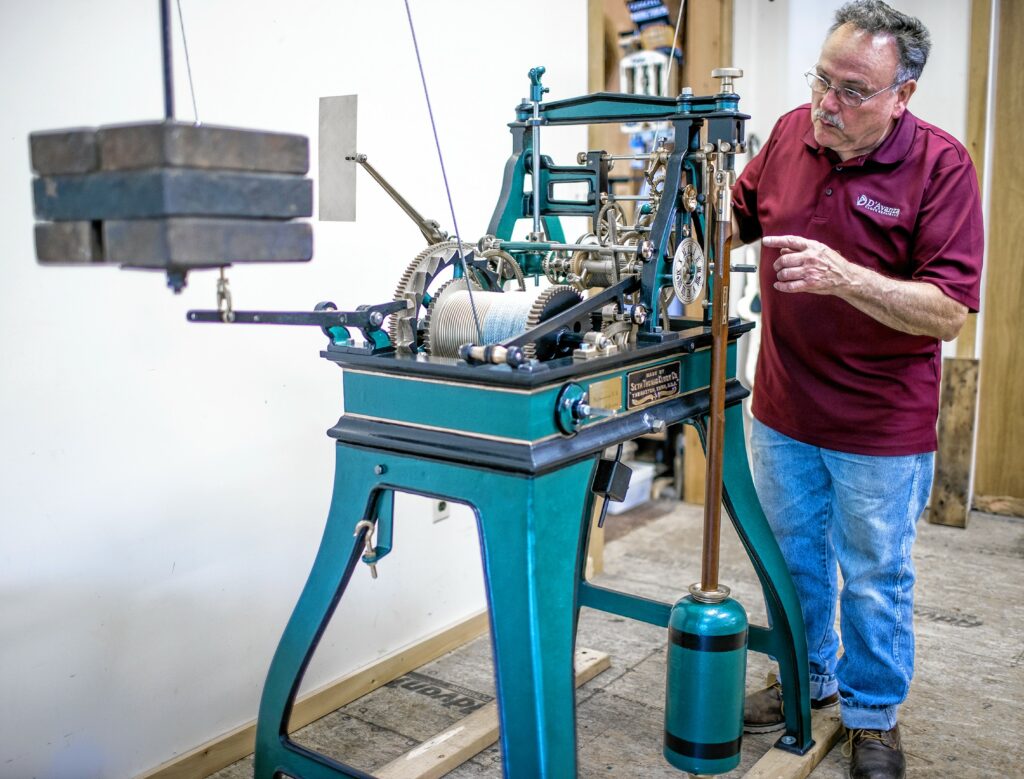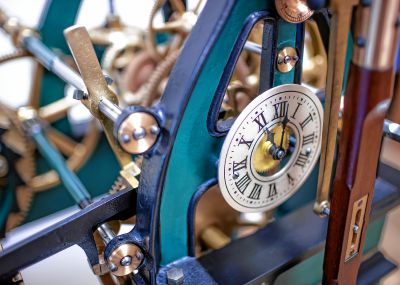Considering they sit at the top of the tallest buildings around and are designed to be easily visible, the hundreds of big town hall and church clocks around New England face an odd problem.
“They’re out of sight, out of mind,” is how Philip D’Avanza puts it.
D’Avanza should know. He is one of the few people in the region who maintains, repairs and upgrades the big, mechanical systems that turn the hands on large clock faces atop towers throughout the region – more than 100 of them in New Hampshire alone. After 40 years in the business, including a dozen in Goffstown just south of the Dunbarton line, he has worked on tower clocks from throughout New Hampshire, including the former Board of Trade Building clock that sits prominently on North Main Street, as well as the rest of New England and New York.

Often he is called in to fix neglect of a century-old clock mechanisms that exists at the top of scores of rickety, seldom-used stairs. Unless the time and striking mechanism are still hand-wound once a week – many were changed to electrical winding years ago – nobody sees these intricate devices and few people think about them.
“They’ll repair it and have me do maintenance for one year, two years … Then people in town hall retire, and there hasn’t been a budget for maintenance for a couple of years, so people forget about it,” D’Avanza said. “I’ll get a call 9, 10 years later: Is there anybody who works on clocks? It’s not working any more.”
His current project on the town hall clock in Westmoreland, west of Keene, is typical in that he has spent nine months undoing years of accumulated wear and tear, although unlike many of his projects it still worked.
He started by having the many-hundred pound assembly of the Seth Thomas No. 15 clock, installed in 1916 to turn the hands on four six-foot clock faces, hauled to his shop. There he took it entirely apart to determine the condition. “Every single piece of it,” D’Avanza said, gesturing at components on his workbenches. “Every. Single. Piece.”
He made some new components in his machine shop, repaired many others, cleaned them all and repainted them with the original green and gold pattern, using the scores of photos he had taken of the original mechanism as a guide.
He also had to fix some odd problems, including the fact that the 75-pound, cast iron plumb bob at the bottom of the pendulum had been turned upside-down, which changed its center of gravity and slightly altered time-keeping. “Why would anybody do that? I don’t know,” he said, speculating that it was an attempt to compensate for wear and tear of components that were making the clock run fast.
The Westmoreland project has one unusual twist. The mechanism will not be returned to the tower but will be installed in a special glass case on the second floor of town hall so people can see it in operation. Like most tower clocks, the escapement that keeps time is connected to a differential gear that drives four separate rods, each going to one of the clock faces. When it is reinstalled later this month, the short rod that led to the differential gear will be replaced by a 37-foot aluminum rod which will go up through two floors to a shelf that D’Avanza built to hold the differential, which will turn hands on the four faces as before.
D’Avanza also works on grandfather clocks, wall clocks, mantel clocks – the various styles of analog time-keeping devices that use myriad interconnected cogs and wheels and gears and cams to divide up our days. He’s not taking any new customers, however, because demand is too great and the number of clock-repair shops too small.
As for the big clocks found on churches, town halls and a few private buildings, it has been many decades since they served as public time-keeping devices. Now they’re decorative, nostalgic and symbolic but that doesn’t make them any less important, as reflected by Westmoreland town meeting’s to spend $27,000 to upgrade theirs.
“People care about these,” D’Avanza said. “They’re beautiful.”


 Return to the Concord Monitor
Return to the Concord Monitor